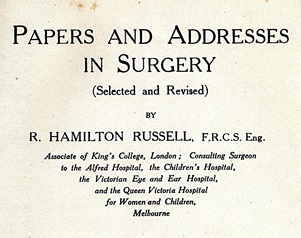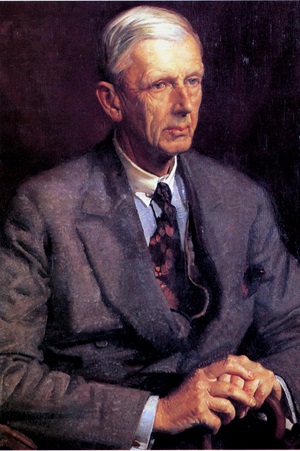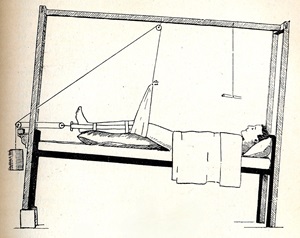2024 | Volume 25 | Issue 5
Author: Dr Peter F Burke FRCS FRACS DHMSA
Specialty Editor-Surgical History: ANZ Journal of Surgery
The first office of the College, in 1930, was a rented single room at 6, Collins Street, Melbourne, measuring approximately 10 feet by 12 feet. As director-general of the College, Dr Robert Hamilton Russell, then an old man, would take the chair at meetings of the Executive Committee—from 1931 his appointment was re-designated as Censor-in-Chief.1
This committee comprising the treasurer Sir Alan Newton (1933-43), and Councillors A l Kenny (1927-44) and Sir Hugh Devine (1939-41), along with Julian Ormond Smith (1933-36) as secretary of the College, met every Wednesday at 12.45pm, Smith noting: ‘Hamilton Russell would shortly fall asleep’: the meeting terminated at 2pm, when, ‘the alarm clock would explode, and the meeting would adjourn’.
A later College archivist, Dr Russell Howard, FRACS observed in his 1981 biography of Hamilton Russell, that he ‘never possessed of robust health, in his declining years he suffered greatly from osteoarthritis of both hip joints. He died in 1933, as a result of a motor-car accident, a collision with a centre-of-the-road lamppost, whilst driving himself into town’. Perhaps the somnolence observed at meetings two years earlier contributed?
One can learn much about Hamilton Russell by consulting his Papers and Addresses in Surgery, published in Melbourne in 1923 and dedicated to George Adlington Syme.2

Dr Russell states in the preface: ‘this chronicle of individual surgical endeavour has been compiled in response to the encouragement of numberless personal friends, more especially my former colleagues, house-surgeons and students.
‘My thoughts revert to the time, now some 35 years ago, when I first entered the wards of King’s College Hospital as a student under Lister’: in fact, he was the last house surgeon to serve under Lord Lister, recalling that ‘the dressing of a wound by Lister became a very beautiful and complete work of art’.

Robert Hamilton Russell
Over his lifetime Dr Hamilton Russell was also inspired by Lister’s qualities as a great experimental investigator, clinical observer, and student. Unsurprisingly, this admiration resulted in the extraordinary scope of his surgical practice, revealed by the volume’s contents, which include, hernia, fractures and their treatment, urethral stricture, surgical tuberculosis, cleft palate, and ‘The removal of large pin from the lower lobe of the lung by thoracotomy’!
Robert Hamilton Russell was born on 3 September 1860 at Farningham, Kent, the youngest son of a farmer. He entered the medical school of King’s College Hospital in 1878 gaining the qualifications of MRCS in 1882 and LRCP in 1886.
He was chosen as dresser and then house surgeon to Lord Lister before continuing his training both in England and on the continent, obtaining Fellowship of the Royal College of Surgeons of London in 1889.
It was then that a medical issue, possibly pulmonary tuberculosis, intervened: Dr Russell elected to emigrate to Australia for the benefit of his health, arriving in 1890, and in May of that year was registered to practice medicine in the colony of Victoria.
After a short time in general practice in Hawthorn, he took up the position of honorary demonstrator in anatomy at the University of Melbourne, and in 1892, was appointed surgeon to the Children’s Hospital in Melbourne.
Dr Russell became particularly interested in the problem of inguinal hernia in the young and read his first paper on the subject at the Intercolonial Medical Congress in Brisbane in 1898. The following year published in The Lancet The Aetiology and Treatment of Inguinal Hernia in the Young. These works brought him world recognition.
In 1901 he applied successfully for a position on the honorary surgical staff of the Alfred Hospital. He was active in professional organisations, held in high esteem by his colleagues and was elected president of the Medical Society of Victoria in 1903.

Hamilton Russell suspension
Around this time, he evolved his method for treating fractured femur in the child, in which no splint was used, and suspension of the fractured limb and traction of the fracture were performed by the same weight, known as ‘Hamilton Russell suspension’.
The Lancet of 9 September 1905 published Russell’s, Removal of a large pin from the lower lobe of the lung by transpleural pneumotomy. The author modestly noted: ‘The first case of the kind in surgical history. It was, of course, only rendered possible by the aid of the then recently discovered X-rays; and it is to my good fortune, rather than to any special skill, that I owe the privilege of including it in this volume’.
The patient was a 12-year-old boy who accidentally swallowed a three-inch length shawl pin; the pin disappearing down his trachea with no cough or glottic spasm.
Russell recorded, ‘the project of extracting the pin through an opening in the chest wall looked as though it should be an easy matter; nevertheless, it was novel work, and I had reason to be very glad that, before undertaking it upon the living, I sought an opportunity of studying the matter in the dead-house, thus gaining a little special tactus eruditus.’
Surgery was undertaken at the Alfred Hospital with the patient placed on his right side. A free curved incision with the convexity downwards was made, and 15 cm of the left eighth rib removed inducing a pneumothorax. Essentially by digital palpation the pin was localised and removed. The boy, perfectly well, was discharged from hospital 12 days later.
Being in England at the outbreak of war in 1914 Dr Russell joined the British Expeditionary Force. He was sent to France where he served in Lady Dudley’s hospital. He returned to Australia in 1918, with the rank of colonel and became attached to the military hospitals in St Kilda Road and Kooyong Road, Caulfield.
In 1920 he retired from the Alfred Hospital and was then specially reappointed to the Children’s Hospital as full surgeon for five years. In the same year he founded the Victorian Association of Surgeons and subsequently from 1925 onwards was occupied in the foundation of what became the Royal Australasian College of Surgeons (RACS).
Dr Russell was tall and handsome, well-spoken and with a distinguished bearing. Although not arrogant in his relationships, he had a personality which drew all to him, fostering goodwill in any gathering.
He was a fine surgeon, always seeking the simplest way. He was an excellent pianist, and an excellent clinical teacher, every case was made the subject of careful, accurate and complete study, and every student was trained to think on surgical lines.
One of the founders of what is now RACS, he was a member of the first Council, elected in 1927 and, on the death of the president, Sir George Syme in 1929, was appointed Director General—an office shortly renamed as Censor-in-Chief. He retained this office and his position on Council until his death.
In 1930 Dr Russell was presented with his portrait, painted by George Lambert, by the Fellows of the College, as a tribute to his work. As a bachelor, this was possibly the proudest moment of his life.
Following his tragic death in 1933, he was cremated, and his ashes returned to England. Hamilton Russell House, intermediate/private section of the Alfred Hospital, opened in 1933 although later demolished in 1997.
References:
1. The History of the Royal Australasian College of Surgeons. Julian Ormond Smith, Hon. RACS Archivist. 27pp College of Surgeons’ Gardens
2. Papers and Addresses in Surgery. R Hamilton Russell FRCS Eng. 452pp. Melbourne, Allan Grant, 82 Collins Street. 1923